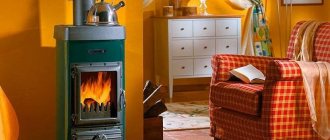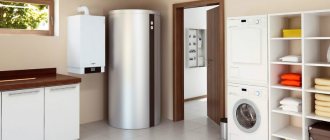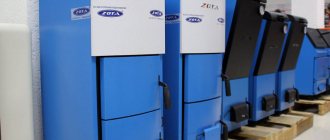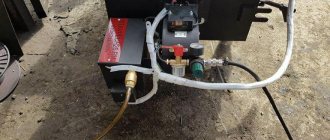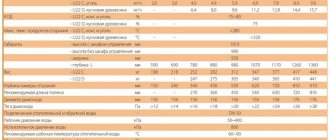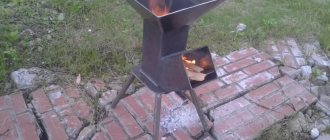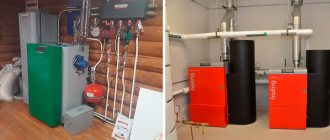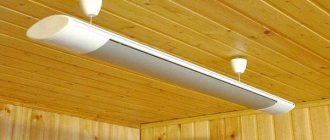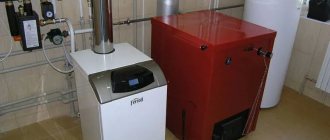Lemax Forward-12.5
- Power, kWt:
13 - Number of circuits:
1 - Type:
floor - Rating:
5.0
Advantages:
- energy dependence
- silent
- powerful
- price
- doesn't heat up outside
Flaws:
- inconvenient to clean
- vertical loading
- small firebox
- it is impossible to regulate smoldering
Solid fuel heating boilers are a worthy alternative to gas heat generators, especially when the house is not gasified. In particular, we are talking about coal models, since coal remains one of the most affordable types of fuel.
It should be noted that modern coal boilers for heating a private home both have functionality and characteristics that are generally much superior to classic stoves, which makes installing the former a truly profitable solution.
Operating principle of a long-burning boiler
Solid fuel boilers appeared relatively long ago, but all of them, regardless of model and manufacturer, had one significant drawback.
Fuel had to be constantly added as it burned. It was ineffective and not economical. This situation continued exactly until 2000, until the Stropuva company found a way to eliminate this problem. It is to engineer Edmuntas Štropaitis that we owe the invention of the long-burning boiler. Today, this is the most practical and functional device for heating a private home or cottage, the performance level of which reaches 70 and sometimes 100%. But, unlike classic pyrolysis boilers, which are also characterized by good efficiency, such units can maintain heat for 7 days with just one batch of fuel!
What are its main technical features and what makes this device so economical and effective?
Long-burning boiler design
The operating principle of a long-burning solid fuel boiler is similar to pyrolysis units. The main heat is generated not from the combustion of wood or coal, but from the gasification of solid fuel. The combustion process takes place in a closed space, from where wood gas is released through a special telescopic pipe.
After this, the gas is directed into the heater nozzle, where diffusion (mixing) occurs with secondary air pumped by the fan. Thus, a continuous process will occur until the coals or firewood are completely burned. In this case, the combustion temperature sometimes reaches 1200 degrees.
Internal structure of a long-burning boiler
The effectiveness of this principle lies precisely in the fact that solid fuel is consumed very slowly, as needed, which significantly increases the efficiency of such a heating device. But not only high performance is the advantage of this design.
As a rule, the whole point of long-lasting combustion is that not the entire load of coal or firewood burns out at the same time, but only the top layer. Due to the fact that air is supplied from above and not from below, fuel burnout occurs gradually, in its upper layer.
Long burning principle
When this layer burns out, the air supply is turned on, and exactly as much as is needed to burn the top layer. This ensures such a burning duration and the ability to control the process.
It should be said that this version of the heating device is acceptable exclusively as a heating system. If you need to think about a water heating system for domestic needs, then you should look for other options.
If the option is selected specifically for heating a large house, then such a device is an excellent alternative to electric and gas appliances.
Advantages and disadvantages of equipment
Using a boiler for heating with coal in a private house is accompanied by several positive aspects:
- ease of maintenance;
- high efficiency;
- uninterrupted operation throughout the full season;
- possibility of combination with wood raw materials;
- process automation;
- provided smoldering operating mode;
- efficiency.
Weaknesses of the equipment:
- the boiler room must be ventilated - this is a mandatory condition for fire safety;
- the need to arrange a technically complex chimney;
- you need to equip a dry place for storing coal.
The heating system usually operates together with a smoke exhauster and a fan; these are quite energy-intensive mechanisms.
What are modern boilers equipped with?
Most models of domestic and foreign manufacturers are equipped with thermal insulation, which helps reduce heat loss. In such boilers, a control unit equipped with a fan often replaces an automatic draft regulator.
To adjust the combustion intensity, you can select an automatic or manual air supply regulator to the combustion chamber. Low-power boilers with manual adjustment are convenient to use because they allow you to adjust the draft in accordance with the selected temperature regime.
Double-circuit solid fuel boilers are also in great demand, performing two functions simultaneously: heating the premises of the house and providing its residents with hot water. When choosing a device, it is worth determining for yourself whether it will be the main or auxiliary element of the system.
Scheme: operation of a solid fuel boiler
If you focus on the cost of a solid fuel boiler, then it is better to give preference to units from foreign manufacturers in the middle price segment. The only significant difference from expensive analogues will be the absence of complex electronics.
Its main task is to control the combustion process taking into account the temperature of the interior and exterior air, thereby simplifying the operation of the unit.
Firebox rules
The instructions state that:
- The fuel is loaded in such a way as to fill the entire volume of coal at once.
- For kindling, dry paper or wood chips are laid on top of the raw materials, which are set on fire automatically. The top door is open, but the air duct is closed.
- When the combustion process has begun, the door must be closed and the telescopic air duct regulator must be turned on.
The required temperature in such boilers is selected automatically. But in some models, adjustment is carried out using an air duct damper.
When the combustion cycle is completed, the remaining raw materials are removed from the loading chamber, the ash pan is cleaned and a new batch is poured.
Rating of combined boilers
A large number of different models sometimes causes difficulty in choosing even for specialists, not to mention ordinary buyers, so we publish the top 5 models. For clarity, let's summarize the data in a table.
Table 1. The best models of 2018-2019
| Model | Fuel types | Description | power, kWt | Efficiency,% | Weight, kg |
| ZOTA MIX-20 | Coal, firewood, gas, diesel fuel electricity | A model from a Russian manufacturer that consumes basic types of fuel without problems. Withstands short-term pressure increases up to 4 atm (working 3 atm). The material of the heating elements is a seamless stainless steel tube. Their operation is controlled by an external control panel. The device is also equipped with a draft regulator and a thermomanometer, which increases the efficiency of the combustion process. To protect against heat loss, the water jacket is insulated. Wear resistance of the outer casing is achieved thanks to powder paint coating. | 3-9 | 80 | 140 |
| KARAKAN 16TPEV 3 | Firewood, gas, electricity | The dual-circuit model of the Russian manufacturer is especially popular among rural residents, because It is equipped with a wide hob on which you can cook food for yourself and your livestock. The unit can easily heat an area of up to 160 sq.m., this applies not only to residential, but also to industrial premises, incl. greenhouse or garage. The depth of the steel firebox is 0.56 m. The “water jacket” prevents the metal from overheating or burning out, which makes the device’s service life long. | 9 | 75 | 120 |
| Teplodar Cupper PRO 22 | Firewood, coal, gas, pellets | The domestic model can easily heat rooms up to 220 sq.m. When using firewood or coal, the unit acquires the features of a long-burning boiler, since on one tab the operating period is 8 and 10 hours, respectively. Another plus is the spacious firebox, which can accommodate firewood up to 600 mm long. | 6 | 80 | 115 |
| Kiturami KRM 30R | Firewood, briquettes, coal, diesel. | The double-circuit boiler from South Korea is equipped with several combustion chambers and electronic control. Capable of heating a room up to 350 sq.m. The heat exchangers are made of alloy steel, so you should not increase the pressure too much. | 35 | 85-92 | 170 |
| Protherm Bison 40 NL | Gas, diesel, fuel oil | The double-circuit model from Slovakia is capable of heating areas up to 400 sq.m. The control is carried out using a microprocessor, and the electronic display clearly shows the operating parameters of the boiler at any given time. | 38 | 89 | 148 |
Appearance of the Protherm Bizon 40 NL boiler
Materials for making the case
Manufacturers produce heating units in housings made of various materials.
Steel
Solid fuel boilers in a steel casing.
Inexpensive options are made from thin sheets. High-quality boilers are made of heat-resistant or high-carbon metal 4 mm thick. The advantages of boilers in a steel casing include:
- withstand temperature and pressure fluctuations;
- ease of transportation and installation;
- maintainability - cracks are treated with a welding machine.
The disadvantages of the devices are the risks of heat exchanger corrosion, thinning and burning of the walls, and the inability to increase power.
Cast iron
The body is made of cast iron, the service life of which is more than 25 years.
The boiler in the cast iron body is made on the basis of cast plates connected by bolting. The joints of the parts are treated with heat-resistant sealant. Thanks to the design, sections can be added to increase power. The advantages of boiler systems include:
- corrosion resistance;
- long-term operation - about 50 years;
- heat capacity due to the properties of cast iron and a small heat exchanger;
- maintainability - just replace or add a section.
The disadvantages of a cast iron body are cracking during temperature fluctuations, low efficiency and a one-pass heat exchanger.
Operating principle of the equipment
The working process is based on the combustion of fuel in the corresponding chamber
It is important to note that different materials can be used as fuel. For example, for a combination boiler, wood and coal are not the only energy sources
Such models can accept briquettes, pellets, husks and shavings. But for this it is necessary that the design of the chamber be oriented towards working with other types of solid fuel.
Regardless of the type of raw material consumed, the firebox releases thermal energy, which can be directly converted into hot air flows, or go into a heat exchanger to heat water. If a coal-fired boiler is used, the combustion process will be long and the thermal energy potential will be high. In contrast, low-density dry firewood or briquettes with chips burn quickly, leaving little heat but a lot of ash and ash.
Coal boiler power calculation
If you incorrectly calculate the boiler power required to heat a group of specific rooms, even the best models of coal-fired heat generators become useless.
Typically, power is calculated according to the well-known principle, when every 1 sq.m. The area must be provided with thermal energy in the amount of 100 W. However, it should be borne in mind that for this you will need to heat the boiler to maximum, constantly maintaining a high temperature of the coolant.
Important! If we step aside from theory, in real life it turns out that the coal loaded into the firebox first flares up, then burns, and then begins to fade. If you choose a boiler strictly for the heat losses of the house, the owner will be forced to constantly add fuel in small portions. It is much more convenient to select a model with higher power (1.5 or even 2 times) and provide it with a low-intensity combustion mode, which modern technology is capable of.
Automatic boilers
Long-burning automatic coal boilers offered on the modern market are designed on the principle of pellet installations. Their feature is the presence of a burner device and a bunker for loading fuel reserves. The design of the heat exchange part of the units repeats the design of their traditional “brothers”; a fire tube heat exchanger or other multi-pass design is used to transfer heat.
The main feature is the retort type burner. It consists of a bowl - a retort, a feed auger with a gearbox and an electric motor, and a fan for forcing air. Coal from the hopper will fall into the receiving hole of the feed auger, which moves it into the bowl. The latter has side slots for the flow of air pumped by the fan.
Such a coal-fired boiler is fully automated, from the electric ignition operation to the control of combustion intensity. The operating time of the unit is not limited by the fuel supply, which can be replenished by pouring it into the bunker on the move. Only the frequency of maintenance and cleaning requires stopping the boiler once a week.
A prominent representative of this type of heater is an automatic coal boiler of the Heiztechnik brand, equipped, in addition to the main components, with a circuit for supplying hot water, a circulation pump and a programmable controller with the ability to connect external thermostats. The controller controls the operation of the burner and can stop it at any time, which is a significant advantage for solid fuel units. Another plus is the ability to quickly install a grate, remove the burner and continue working with traditional direct combustion of fuel in the firebox. The efficiency of the unit is declared by the manufacturer at 88%.
The disadvantages of a coal boiler with a screw burner are its high cost and demands on the quality of fuel. The Heiztechnik manufacturer's requirements are as follows:
- fraction size – no higher than 25 mm;
- humidity – up to 10%;
- dust content in fuel – no more than 20%;
- coal for automatic boilers - medium-coking, type 31 or 32, not higher.
Rules for starting and stopping the boiler
Maintenance of high-power productive equipment is carried out by qualified personnel.
The first start-up is practically putting the unit into operation. In the future, the responsible person monitors the condition of the device, and in case of an emergency, calls specialists. But even before the brigade arrives in an emergency, it is necessary to close the slide valve and block the access of oxygen to the chamber. The boilers are equipped with sensors that, in such a situation, will reduce the pressure without manual intervention.
If the process is fully automated, then in the event of an accident a signal is given from the remote control to turn off the equipment.
Advantages of boilers of this type
As mentioned above, a modern coal-fired boiler has much in common with a classic Russian stove. But if a hot brick fireplace directly heats the air in the house, a coal boiler heats water, which then circulates through the radiator system of the heated room.
In all other respects, solid fuel boilers for heating a private house embodied the versatility of their original Russian predecessor. For example, they are unpretentious in the choice of combustible material and allow you to charge firewood, briquettes, pellets, sawdust, paper waste, rags, which in itself is a good idea for recycling combustible waste.
On the other hand, of course, operating a boiler using “frozen” fuel requires more control: you will have to monitor instrument readings and replenish the tank more often. And since such raw materials burn unevenly, temperature changes are possible in the radiator system. Not to mention the fact that garbage that is not used as fuel leaves carbon deposits and soot that need to be cleaned.
Therefore, despite the abundance of waste fuel, prudent (read lazy) owners acquire a large supply of long-burning coal. Using such a heat source, the stove can operate for several days without requiring additional maintenance, cleaning or even refueling.
Unlike a Russian stove, which requires compliance with a certain kindling technology, a coal boiler is extremely easy to use - just open the firebox and throw coal inside
This operation requires a minimum of precautions; the installation and operation features of a coal boiler mean that all potentially dangerous processes are controlled automatically
Another advantage of a coal boiler is its high efficiency, and the use of modern energy-saving technologies has doubled the productivity of new solid fuel boilers compared to old-style coal stoves.
Of course, for a city dweller, spoiled by centralized heating and water supply, the need to load the tank from time to time may seem tedious, but only at first glance. Almost all modern coal-fired boilers make the most of a single load, and temperature control is carried out by sensor systems and air supply devices.
Due to their high efficiency and safety, coal fuel boilers are successfully used for heating cottages and summer houses, residential buildings and offices. But, of course, coal equipment finds ideal use in private residential construction, where its surface can also be used to heat food.
The best known manufacturers and models: characteristics and prices
Recently, Russian coal boilers have become increasingly popular: their quality is constantly improving, and the cost remains quite low compared to foreign analogues. However, the most functional and automated boilers still remain from European manufacturers. Please note that almost all models have different power versions.
Direct combustion
ZOTA "Master" 20
ZOTA “Master” with a power of 20 kW is a very budget-friendly insulated (basalt cardboard) boiler that can withstand pressure up to 3 bar and runs on almost any fuel: coal, wood, pellets and gas (optional). It also uses electricity as an auxiliary heat source (TEH).
Country of origin: Russia, LLC TPK KrasnoyarskEnergoKomplekt.
Protherm “Beaver” 20 DLO
Protherm “Beaver” with a power of 20 kW is a non-volatile boiler with an operating pressure of up to 4 bar, which has an increased service life because it uses a high-tech (GG20) cast iron heat exchanger that is resistant to corrosion and thermal shock. You can only burn with various types of coal and wood.
Country of origin: Slovakia, Vaillant Group LLC (Vailant Group rus).
Bosch "Solid" 2000 B SFU 12
Bosch “Solid” 2000 B SFU with a power of 13.5 kW is a simple, reliable boiler designed for the use of brown coal, but can also burn coal, coke, firewood and wood waste. Equipped with a built-in pressure control device (no more than 2 bar), thermal protection and gas swirlers.
Country of origin: Germany, Bosch LLC (Bosch Thermotekhnika rus).
Long burning
Stropuva S15U
Stropuva S15U with a power of 15 kW - thanks to the volumetric firebox that can hold up to 240 kg of coal, this innovative boiler is an unsurpassed leader (among compact devices) in terms of burning time on one fill: up to 7 days. Consumes coal, pellets, briquettes and firewood, at a maximum pressure of up to 3 bar.
Country of origin: Russia–Lithuania, STROPUVA LLC (STROPUVA).
Cost: 81,500–99,778 rubles.
Boilers with a burning duration of one load of fuel up to 7 days
Buderus "Logano" S181-15 E
Buderus “Logano” S181-15 E with a power of 15 kW is one of the best automatic bunker coal boilers for heating a private home, with built-in water and gas temperature sensors. The improved heat exchanger design ensures long-lasting combustion of coal/pellets and can withstand pressures of up to 3 bar.
Country of origin: Germany, Bosch LLC (Bosch Thermotekhnika rus).
Cost: 252,000–258,840 rubles.
LIEPSNELE L20U
LIEPSNELE L20U with a power of 20 kW is an almost “omnivorous” solid fuel unit that consumes coal, firewood, coal briquettes and pellets, peat, wood shavings, other wood waste, etc. When fully loaded with coal, it maintains combustion for up to 7 days. The pressure level is limited to 1.5 bar.
Country- UAB (Vakaro Rasa).
Galmet "CARBO" 21
Galmet “CARBO” 21 with a power of 22 kW - a Polish semi-automatic coal-fired boiler already in the basic configuration has quite a lot of equipment: a smart PID controller that controls all components of the boiler and controls the combustion process, a flue gas sensor, a thermometer and a pressure gauge. Pressure limit – up to 2 bar.
Country of origin: Poland-Russia, GALMET LLC (GALMET-RUS).
Cost: 113,890–116,759 rubles.
Criteria for selecting long-burning solid fuel boilers
We have already become familiar with the general classification of solid fuel boilers. It's time to consider the criteria by which owners of private houses determine the optimal options for units for installing heating systems. After reading the following sections, you will learn how to choose the right long-burning solid fuel boiler for your home.
Type of fuel
First of all, you must decide what fuel will be used for heating. Based on what type of fuel is more convenient to buy and import. If you have harvested wood, it would be wise to purchase a wood-burning boiler. Owners of cottages where there are no trees can recommend heating with pellets. Coal boilers are suitable for those who have the opportunity to order high-quality fuel on favorable terms. Sawdust heating systems are typically used to heat wood processing facilities.
Boiler power
To determine the required power of the heating system, you need to make simple mathematical calculations. Calculate the total volume of the premises you are going to heat. The resulting figure will help you find a model with the appropriate parameters in a wide range of long-burning solid fuel boilers. Keep in mind: you should always provide a power reserve so that during severe winter frosts the house does not become cold.
Device weight
When choosing a long-burning solid fuel boiler for heating a private home, the mass parameter is taken into account only if the owner intends to mount the purchased unit on the wall. According to state standards established by the Russian gas service, this installation method is allowed for heating boilers with a volume of less than 100 liters
Loading chamber volume
This parameter characterizes the ratio of the volume of fuel supplied to the power of the heating unit. The more fuel that fits in the loading chamber, the less often you will have to replenish the supply of firewood/coal/pellets. For steel boilers, the ratio of these values is 1.6-2.6 l/kW. Cast iron heating units consume fuel in smaller quantities - 1.1-1.4 l/kW.
The total volume of the loading chamber will help you roughly estimate the capabilities of the boiler. In any case, you will not be able to fill it 100%. The usable volume of the loading chamber is much more important. This value reflects the actual amount of fuel that you can load into the combustion chamber. To determine it, you need to know the principle of combustion of the selected boiler and the method of loading fuel (top or front).
Boiler efficiency
One of the most important parameters for any long-term combustion solid fuel heating unit. The figure expressing the efficiency of the boiler characterizes that part of the generated thermal energy that is actually spent on heating the home. By choosing a unit with a high efficiency, you can reduce power requirements. Low efficiency means waste of heat, so you will have to add more fuel to maintain an acceptable temperature in your home.
Which one to choose: details about the characteristics worth paying attention to
The project will help you make the right choice; it specifies all the requirements for design parameters, communication connection options, installation details of the room, etc. Special attention in the documentation is paid to the operational characteristics of the device itself.
Direct, long burning or pyrolysis
Comparison of coal boilers using different combustion technologies:
| Direct combustion | Long burning | Pyrolysis | |
| Maximum efficiency | 65–75 % | 78–84 % | 85–92 % |
| Autonomous operation | no Yes | no Yes | Yes |
| Energy dependence | no Yes | no Yes | Yes |
| Refueling period | 6–10 h/—— | 12–18 hours/1–2 days* | 24–30 hours/4–7 days* |
| Fuel moisture | w ≈ 30–50% | w ≈ 20–30% | w ≈ 7–15% |
| Acceptable faction | up to 60–80 mm | up to 25–50 mm | up to 5–25 mm |
* refueling period taking into account the built-in automated bunker
We can conclude that there simply cannot be a more efficient combustion of fuel than in an automatic pyrolysis boiler, so if the homeowner’s plans do not include night refueling and constant supervision of the operation of the unit, then it is better to choose this option.
However, it is worth taking into account its demands on fuel quality and pre-emptively looking for a reliable supplier of fine-grained coal or purchasing a crusher. In addition, such a heater only works in conjunction with automation, i.e. it needs to provide uninterrupted access to power.
Primary heat exchanger (housing) material
The material from which the body of a coal boiler is made is an important factor determining the durability and maintainability of the heating system:
- steel is a lightweight plastic material that can easily withstand changes in pressure and temperature, but is prone to corrosion and burnout;
- Cast iron is a durable material that allows you to use high boiler capacities, but does not withstand shocks and sudden temperature fluctuations.
If there is slight damage to the steel heat exchanger, there is a high probability that the hole will be able to be welded, especially if high-quality “boiler” metal with a thickness of more than 4 mm was used, but if even the slightest crack forms on the cast iron, then the entire part will have to be replaced entirely.
The combined model Viadrus U22 is an excellent example of a combination of a cast iron primary heat exchanger and a steel secondary one.
Many manufacturers prefer to combine the strengths of both materials, so they produce boilers with a steel body, but with a cast iron firebox.
Single-circuit or double-circuit
The heat generated by the boiler is distributed depending on the number of circuits:
- single-circuit - designed exclusively for heating the room, connects to a system of batteries (radiators) and heats water only for them;
- double-circuit - used not only for heating the house itself, but also for heating water for sanitary purposes, as well as for “warm floors”.
Reference . In an instantaneous hot water heater, the heating output must be permanently adjusted in accordance with the water flow.
Since the combustion intensity of solid fuel cannot be changed in real time (dynamically), only a boiler that receives thermal energy from the combustion of gases, i.e., of the pyrolysis type, can be relatively profitable, and even then not always, given the difference in the price of coal according to regions.
It is possible to organize a hot water supply system with one circuit. To do this, you need to connect an indirect heating boiler, which will allow water to circulate not only through the pipes, but also pass into the storage tank (through the built-in heat exchanger), heating the water in it.
Minimum required power and heated area
The most commonly used method in non-professional environments to calculate the required power is the ratio of 100 W of heat per m² of room area:
Q = S × 100
- where Q is the required thermal energy to heat the room (kW);
- S – heating area (m²), 100 – specific power, norm per unit area (W/m²).
For example, for a room with an area of 17.6 m² Q=17.6×100=1760 W ≈ 1.8 kW
Usually the calculation is carried out in the direction “from small to large”. Simply put, the value for each room is determined separately, and then the resulting result is summed up. This allows you not only to find out the required power, but also to subsequently calculate the required number of radiators.
One more nuance: the power is calculated for the highest calorific value of coal that can be burned in the unit. When burning with other coal, such heat production cannot be achieved, therefore it is recommended to make a power reserve of 10–20%, then the equipment will not work at its maximum even in the most severe cold.
How and what kind of coal is best to heat a household solid fuel boiler
Efficiency
The efficiency factor (efficiency) shows the ratio of the volume of fuel consumed to the amount of useful heat generated by the unit.
This is the most important criterion for the performance of heating equipment, so it is obvious that the higher the efficiency, the better. For a coal boiler, as mentioned above, the figure varies between 65–92%, which depends on the design, type of combustion and degree of automation of work processes.
Other important selection criteria
Having decided on the choice of the main parameters of a coal boiler, you can pay attention to the additional characteristics of the unit of interest:
- smoke exhaust device - the degree of heat transfer by gases depends on the chimney elbows, therefore a three-pass system is more efficient than a one-pass system;
- volume of the combustion chamber - the larger the size of the firebox (calculated in l/kW), the less frequently fuel needs to be added and the longer the battery life;
- control and functionality - boiler equipment can be equipped with a thermostat, weather-dependent automation, a self-cleaning system and a mobile GSM module;
- external thermal insulation - good insulation allows you to reduce losses of useful energy, preventing sudden temperature changes and cooling of the boiler;
- presence of lining – combustion chambers with lining are more economical, because they consume 25–45% less fuel at the same power level;
- ensuring safety - to protect against overheating, an external heat exchanger or an independent cooling circuit and an emergency thermal valve are provided.
Reference . The most common type of boiler failure is deformation (folding) of its walls. Contrary to popular belief, this is not due to high pressure (it is released through a safety blast valve), but due to simple overheating, since not all units have built-in protection.
Pyrolysis systems
Scientists have long noticed that the combustion of any solid fuel releases carbon dioxide, which can be used as additional fuel. This process is called pyrolysis. When wood burns, quite a lot of such gas is released. That’s why wood-burning pyrolysis boilers have become so widespread.
The operating principle of such devices is quite simple. Fuel is placed in the first combustion chamber. With little air supply, the firewood smolders and releases pyrolysis gas. which enters the second chamber. Here the gas is burned and heats the coolant of the home heating system.
This device can significantly increase the efficiency of a wood-burning boiler. The efficiency of such devices reaches 90% and higher. In addition, long-burning pyrolysis boilers have other advantages, namely:
- the fuel burns almost completely. There is no need to constantly remove numerous combustion products;
- The boiler operating time on one charge increases. It is enough to “throw” firewood into the firebox once every 15 hours;
- fuel consumption is significantly reduced, which entails savings on heating the house;
- The devices are environmentally friendly. During the combustion of pyrolysis gas, no harmful substances are released into the atmosphere. When they burn, carbon dioxide and water vapor are produced;
- it becomes possible to completely control the combustion temperature;
- Long-burning pyrolysis wood boilers are unpretentious in maintenance.
But, despite all its advantages, pyrolysis equipment is not without its disadvantages. Among them are the following:
- Pyrolysis boilers are quite expensive equipment. For many families, it may simply not be affordable. But such devices will allow you to save on heating your home, which offsets the cost of purchasing equipment;
- boilers are heavy and have impressive dimensions due to their complex structure;
- quite demanding on fuel quality. The firewood must be dry, the efficiency of the device depends on this;
- the need for a constant supply of electricity. The device contains blower fans that require electricity.
The high cost of long-burning pyrolysis heating boilers significantly reduces their popularity. But many craftsmen make such devices themselves. Schemes and drawings can be easily found on the Internet.
Installation features and location selection
A coal boiler for heating a private house must be installed in a separate room. Moreover, the room should be quite spacious and with good ventilation. Non-combustible finishing materials must be used in the boiler room. Often it is necessary to make an additional concrete base for a heavy apparatus.
The installation of the unit is carried out by professionals. It is necessary not only to install the boiler, but also to connect it with heating and ventilation systems. At the same time, various auxiliary equipment is installed - a fan, valves, sensors, a water purification filter, an expansion tank. After installation, a test run is required.
Recently, combined units have become increasingly popular. An example is a gas-coal boiler, which is characterized by higher efficiency and autonomy.
You may be interested in information about what a DKVR boiler is and where it is used.
When the boiler switches from wood to gas
The main type of fuel for a combined boiler is solid fuel. The device can work up to 4-5 hours on one load. Pyrolysis boilers are capable of heating a room for 8-10 hours. The gas burner comes into operation only when the firewood runs out. It maintains the set water temperature in the heating circuit. To avoid unnecessary gas costs, it is recommended to immediately add wood to the stove without waiting for the fire to completely go out.
Solid fuel is the main type of fuel for a combination boiler.
Customer Reviews
Ignat K.
Protherm Beaver 50 DLO 39 kW
Advantages: It has been working since 2014 with virtually no complaints. At the same time, only one inspection took place (one year after installation). Disadvantages: It often turns on to maintain the temperature; it can turn on/off 2 times in 10 minutes. I would like to adjust the hysteresis of the tº spread. After 6 years, something began to squeak when the pump rotates. Comment: One winter it turned off with error F5 - problems with traction. After I removed the ice that had formed from the pipe (and there was actually a lot of it frozen after the snowfall and severe frost), the problem was solved. It seems to me that those who get their entire controller replaced for the F5 error are simply being scammed out of money.
Novel
Teplodar Cooper Praktik 8
Advantages: Electronic control. Quiet operation. Weekly timer Connection of an external thermostat Burner modulation Built-in expansion tank Possibility of using non-freezing coolant Disadvantages: Operation of an anti-freeze system. The manufacturer cannot provide information on the OpenTherm interface, which is declared in this boiler, and the equipment compatible with it. Comment: I was a little disappointed by the breakdown. Immediately after the initial startup, the system board needed to be replaced - the system did not see that the burner was lit. But the issue was resolved directly with the manufacturer. I received the new fee by mail 4 days after applying. I installed it myself. Everything has been working fine for a year now. The service is fine. Incomprehensible anti-freeze system. The pump turns on at +8, turns off at +12, and the burner turns on at +5. And if the temperature falls into the region of +10, then the circulation pump works for days. And if non-freezing coolant is filled in, then this system is not needed at all.
Vladimir Malvinov
ZOTA Box 8 8 kW
Advantages: Good and reliable boiler Disadvantages: I haven’t found it in a year Comment: On the advice of friends, we purchased a boiler. A voltage stabilizer was immediately purchased; in our village we have large power surges, the lights blink frequently. For almost a year of operation, the boiler has never been repaired, only scheduled maintenance. . The reliability and safety of the boiler is also at the highest level. Heat exchangers can withstand the test of fairly hard water. There are no complaints, we are completely satisfied with the purchase, everything is simple and clear. I advise you to buy!
Kirill M.
ZOTA Topol-22VK 22 kW
Pros: Excellent boiler. There are commissioning features. Reading the manual!!! By default, the turbo water heating mode is set, which is needed if you have a long distance from the boiler to the point of water consumption; the water is heated to 70 degrees immediately. If you have a bathroom behind a wall, it is better to turn off this mode in the settings. In the second mode, the boiler is set to maximum heating output, so if you place the boiler in a small room, it is better to also reduce the heating. This is important, and then you will be happy and there will be no problems with operation. And also, if there are problems with water pressure, then install a mixer with separate valves (do not install joysticks), but this applies to any boilers.
Vasily D.
ZOTA Topol-16VK 16 kW
Advantages: Relatively compact, somewhat stylish, the interface is clear from three notes Disadvantages: Not eternal Comment: I used it for two years and had no problems. Now I don’t know either, only the boiler has become a little louder. If I get tired of it, I’ll take it to the service center with a guarantee. I don’t really understand people who expect their systems to work forever and without problems, everyone’s water is different, and the hands of installers and servicemen are screwed differently every now and then. I took the extended warranty and can continue to live in peace.
Nikolay V.
ZOTA Topol-32VK 32 kW
Advantages: Reliability, functionality Disadvantages: Noisy Comment: Last year we selected a gas boiler for heating. We looked at more than one option and chose the Lemax Premium-30V boiler. We consulted with neighbors and gas workers. We looked on the Internet. Lemax is produced in Russia. This means they are adapted to our Russian realities, unlike imported ones. This is a floor-standing, double-circuit boiler with an open combustion chamber; combustion products are removed naturally through the chimney. It will heat the house and heat the water. Electronic control. The quality is top notch. This is confirmed by those who already use such boilers and those who service them. The boilers are reliable, and if something happens, they are repairable. Spare parts are always available and at low prices compared to imported ones. We ourselves were convinced of the quality of the boiler. Last winter, and it was frosty, he proved himself to be the best.
Ignatov B.
ZOTA Topol M 14 14 kW
Advantages: compact, does not require an electrical connection, economical, easy installation and management. Disadvantages: everything suits me, otherwise why would I buy it. Comment: If you are looking for a good, high-quality boiler that is easy to install and control, then Lemax Patriot-16 is the best choice. I installed it in my apartment and am completely satisfied with its performance and functionality. In addition, I began to pay several times less for heating when I connected autonomous heating and refused the services of the heating network. The boiler does not require connection to the electrical network, which was also important for me. And the fact that the boiler is floor-standing is also a small thing; it doesn’t take up much space and fits perfectly into the overall interior.
Mikhail D.
Lemax Forward-16 17 kW
Pros: Good appearance, not embarrassing to hang. Disadvantages: Error e48 Comment: Selecting a double-circuit boiler took a long time and painfully. In the end we settled on Lemax Prime-32. I liked the boiler for its unobtrusive appearance (it hangs on display) and the quality of its build. It works flawlessly, high-quality automation and reliable security systems are installed. At first, after starting there was a problem - the injector was burning with a red-blue flame, a service specialist was called. Even a child knows that fire should only be blue. The reason turned out to be excessive pressure in the system, after adjustment everything became normal. We are happy with the boiler; there is enough power for both heating and hot water.
Vladimir Malvinov
Bourgeois-K MODERN-12 12 kW
Pros: Yes, everything is good. Quiet, stable, I almost forgot about him that he existed. Disadvantages: EA’s favorite mistake, but it’s solved, I’ll tell you how below. Comment: I installed it at the dacha, connected it and configured it myself. Powered by LPG from a gas tank. Installed it, configured it according to the instructions and everything worked. A day or two and a “favorite” mistake. It starts up normally, then goes into it (I don’t know about others, but for me it popped up right at the moment the burner started). I started racking my brains. After a day of experimenting, I finally discovered the reason. The boiler starts up very smoothly and silently, the burner slats light up smoothly, one after the other. But!!! The burner igniter and the flame control electrode are located at the maximum distance from each other. As a result, sometimes the flame simply did not have time to reach the flame control electrode in a given time (the boiler has a certain time constant in its brain during which the flame should appear), the boiler, accordingly, thought that was all, and attempted to restart. Everything was repeated, and if (in my opinion, on the third attempt) he still didn’t see the flame, he fell into error. (Here I’ll get ahead and say, based on the results of observations, the speed at which the flame passes through the lamellas of the burner depends on the gas!!! From one filling it goes slowly, from another it goes much faster.) Step one - moved the flame control electrode to a different position (provided there is another place for it closer to the igniter). The situation has improved, but not completely. I thought some more and did it - The second step was to slightly increase the gas pressure in the minimum power mode (by 7 percent, from that recommended by the manufacturer) That's it. The flame consistently manages to reach the control electrode within the required time interval. More than 3 years have passed, I saw this error only twice during this time - I was a fool myself, I missed the moment when it was necessary to refill the gas tank and the gas simply ran out. The idea that this might be related to the quality of the gas came to me almost immediately. Therefore, I began to monitor the ignition of the boiler after each refueling. And I discovered that at different gas stations, the speed of flame spread is different. Somewhere faster, and somewhere slower.
Rashid Khalikov
TRAYAN T-20-1KT
Pros: Great boiler! Installed and started immediately. There is not a word in the instructions that to connect to wi-fi you need to screw the antenna to the module. The place where to screw the external antenna is described in the instructions as a “Technical plug”; to enable the detection mode, you need to press two keys, but it does not say what exactly when the boiler is turned off. In general, everything worked out using the “poke-poke” method! Disadvantages: An ordinary Russian person, after reading the instructions 5 times, will not be able to set up the boiler without having the skills to “poke” all the buttons. Update the instructions for this model, the wi-fi indicator is either on or blinking, and not as indicated in the manual. Otherwise everything is fine. I connected a temperature sensor in the house and set temperature-dependent modes. Everything works like clockwork.
Dmitry Zyuzin
ZOTA Topol-22VK 22 kW
We have been using this boiler for a season now. Of course, we had the boiler installed by specialists. At the beginning I had difficulties with the setup, but when I figured it out it turned out to be easy and simple. When the boiler is operating there is no noise, you can hardly hear it, in silence you can actually hear it turning on and off a little, but not much. Moreover, it turns off very rarely for me since it is set to the minimum permissible power, the specialist who installed this boiler explained to me that in this mode it works economically, its efficiency is greater and it consumes less gas. There are no particular problems with the settings, since I immediately installed a temperature sensor on which I set a comfortable temperature in the room to 25 degrees and then the boiler itself regulates its power and maintains the desired air temperature in the room, this is very convenient especially if you leave for a long time in winter Houses. For the successful operation of this boiler, electricity is needed, so if the electricity is turned off at some point, the boiler turns off, but it turns on itself as soon as electricity is provided. To reduce interruptions from power outages, you can, of course, use a battery, but I didn’t install it because we don’t have blackouts for long, the batteries don’t even have time to cool down.
Leonid Pavilenkov
ZOTA Topol M 14 14 kW
I always choose everything for quality, even if the appearance is not so attractive. But in this case, this boiler is good both in quality and in appearance. We have all heard about German quality; they know how to make durable and reliable equipment. It doesn’t bother me about noise, and even if you make the room properly in your house where the boiler is located, the sounds won’t be heard at all in other rooms. It doesn’t take up too much space, it hangs quietly and doesn’t get in the way. The adjustment is simple, although at first I had to call the experts to set it up; the instructions did not help, but the guys explained and approved the boiler. As I understand from talking with neighbors, their gas fees are more expensive, although there is no significant difference in the size of the houses, here again I guessed right with the purchase of the boiler. The repairs were not yet completed, the boiler was working. Sometimes the electricity went out, however, the boiler is smart; when power is supplied back, the boiler turns on on its own, which is a plus for the developers. Works well at low temperatures, there is an automatic function for this in it. Already checked by finishers. In general, the boiler is thought out for a comfortable stay in your home.
